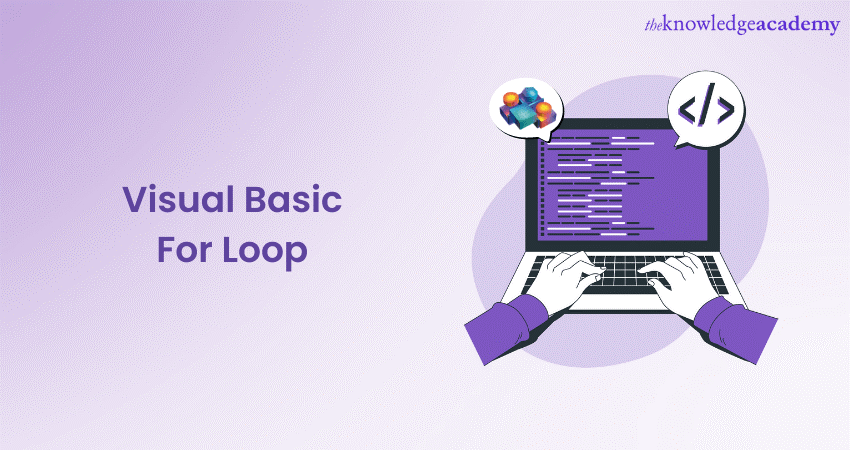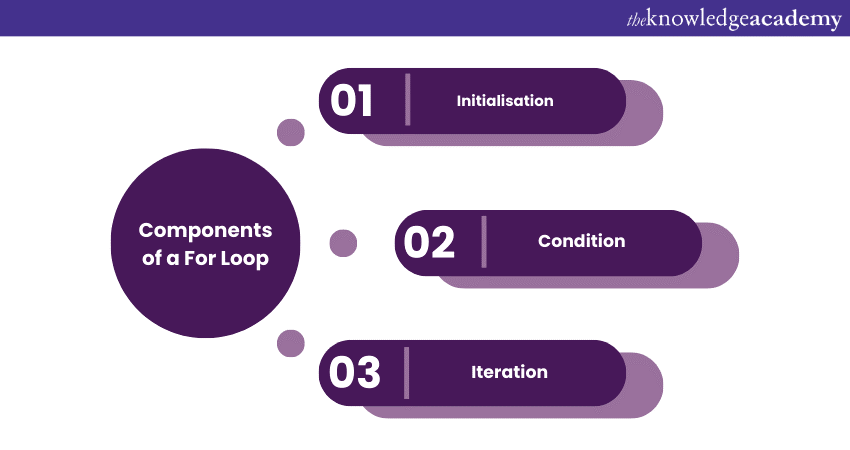We may not have the course you’re looking for. If you enquire or give us a call on 01344203999 and speak to our training experts, we may still be able to help with your training requirements.
Training Outcomes Within Your Budget!
We ensure quality, budget-alignment, and timely delivery by our expert instructors.

Loops are an indispensable programming aspect, enabling developers to automate repetitive tasks efficiently. The Visual Basic For Loop stands out for its simplicity and versatility among the various Loop constructs available. By allowing you to iterate through a specific range of values, the Visual Basic For Loop empowers programmers to perform actions with precision, making it an essential tool in a developer's arsenal.
Whether a novice or an experienced programmer, mastering the Visual Basic For Loop opens doors to more efficient and elegant code solutions. In this blog, we will understand Visual Basic For Loop, break down its components, and offer practical examples to clarify. Read more to find out!
Table of Contents
1) Understanding Loops in programming
2) The basics of For Loops
3) Components of a For Loop
4) Writing your first Visual Basic For Loop
5) Advanced usages of For Loops
6) Conclusion
Understanding Loops in programming
Loops lie at the heart of programming, embodying the art of repetition. They enable developers to execute a specific code block multiple times, eliminating the need for redundant manual interventions. Visual Basic For Loops exemplify this concept, effectively iterating through a predefined range of values. By comprehending the essence of Loops, programmers gain the ability to streamline processes, manage data more effectively, and create dynamic applications.
Learn to use Class Designers efficiently, sign up for our Visual Basic Programming For .NET now!
The basics of For Loops
'For Loops' offer a structured mechanism for executing a block of code a specified number of times. By understanding the core principles of For Loops, developers can harness their power to process data, generate patterns, and perform computations with remarkable precision.
A For Loop operates on three key components: Initialisation, Condition, and Iteration. The Initialisation sets the starting point, initialising a counter variable to a specific value. The Condition serves as the gatekeeper, determining whether the Loop should continue based on the fulfilment of a particular condition. The Iteration defines how the counter variable is modified after each Loop cycle, inching it closer to the termination condition.
The elegance of For Loops lies in their predictability. You know precisely how many times the Loop will run, making them ideal for tasks with a fixed number of iterations. This predictability simplifies debugging and allows developers to focus on crafting concise and effective code.
Components of a For Loop
A For Loop is a foundational programming structure that streamlines repetitive tasks by breaking them down into three essential components. Understanding each of these components is crucial for effectively harnessing the power of For Loops.

Initialisation
At the heart of a For Loop lies the Initialisation phase, where the Loop counter variable is set to an initial value. This step is pivotal as it establishes the starting point for the Loop's iterations.
a) Initialisation variable: Declare a variable that will act as the Loop counter. This variable holds the current iteration's value.
b) Initial value: Assign a value to the Loop counter to determine where the Loop begins its iterations.
Condition
The Loop's Condition determines whether the Loop should continue executing or terminate. The Condition is evaluated before each iteration, controlling the Loop's behaviour.
a) Condition statement: Define a Condition that evaluates to either true or false.
b) Continuation or termination: If the Condition evaluates to true, the Loop continues to execute. The Loop is terminated if it evaluates to false.
Iteration
In the Iteration phase, the Loop counter is updated after each cycle, moving it closer to the termination condition. This step ensures the Loop progresses through the desired range of values.
a) Iteration statement: Specify how the Loop counter should be modified after each Iteration.
b) Increment or decrement: Common Iteration methods involve increasing (incrementing) or decreasing (decrementing) the Loop counter.
Writing your first Visual Basic For Loop
Embarking on your journey with Visual Basic For Loops is an exciting step towards mastering efficient programming techniques. Let's dive into the process of writing your first Visual Basic For Loop, complete with a clear example to illustrate its application.
Ready to master the art of Programming? Sign up for our Programming Training now!
Step-by-step guide
Define Initialisation:
a) Declare a Loop counter variable (e.g., 'i') and assign it an initial value.
b) Determine the starting point from which the Loop will begin its Iterations.
Set the Condition:
a) Specify the Condition that determines whether the Loop should continue executing.
b) Define the endpoint or a Condition that, when met, stops the Loop.
Code the Iteration:
a) Determine how the Loop counter variable will be updated after each Iteration.
b) Choose whether to increment ('i = i + 1') or decrement ('i = i - 1') the counter.
Example: Printing numbers using For Loop
Here is a simple program using Visual Basic to print numbers from 1 to 5 utilising a For Loop:
|
Module MainModule Sub Main() For i As Integer = 1 To 5 ' Loop from 1 to 5 (inclusive) Console.WriteLine(i) ' Print the value of i Next i End Sub End Module |
In this example, the For Loop iterates through the values from 1 to 5, and for each Iteration, it prints the value of 'i'. The Loop counter 'i' is incremented by one after each cycle. When you run this program, you'll see the numbers 1 to 5 printed in the console.
Advanced usages of For Loops
Beyond their foundational applications, For Loops in Visual Basic unveil advanced programming techniques that enable developers to tackle intricate tasks with precision. Let's dive into some of these sophisticated usages that leverage the full potential of For Loops.
Looping through arrays and collections
'For Loops' shine when traversing arrays, lists, and other collections. By Iterating through each element, you can process, modify, or analyse data systematically.
a) Array iteration: Use a For Loop to access and manipulate each element in an array sequentially.
b) Collection navigation: Traverse collections, such as lists or dictionaries, to perform operations on their elements.
Example: Calculating the sum of elements in an array
|
Dim numbers() As Integer = {10, 20, 30, 40, 50} Dim sum As Integer = 0 For Each num As Integer In numbers sum += num Next num Console.WriteLine("Sum: " & sum) ' Output: Sum: 150 |
Nested For Loops
Nested For Loops involve a Loop within another Loop. This approach is invaluable when dealing with multidimensional data structures, generating patterns, or performing operations on multiple levels.
a) Two-dimensional arrays: Iterate through rows and columns of a 2D array using nested Loops.
b) Pattern generation: Generate complex patterns by controlling two or more Loop counters simultaneously.
Example: Printing a pattern using nested For Loops
|
For i As Integer = 1 To 5 For j As Integer = 1 To i Console.Write("*") Next j Console.WriteLine() ' Move to the next line Next I |
Output:
*
**
***
****
*****
Conclusion
Visual Basic For Loop emerges as a dynamic tool, enabling precise and efficient automation of tasks. Understanding its components and advanced applications empowers programmers to streamline code, tackle complexity, and create elegant solutions. Embrace the For Loop's predictability and control to excel in your programming journey.
PHP is recognised as the most popular scripting language globally, sign up for our PHP Programming Masterclass now!
Frequently Asked Questions
Upcoming Programming & DevOps Resources Batches & Dates
Date
 Python Course
Python Course
Mon 20th Jan 2025
Mon 24th Mar 2025
Mon 26th May 2025
Mon 28th Jul 2025
Mon 22nd Sep 2025
Mon 17th Nov 2025







 Top Rated Course
Top Rated Course



 If you wish to make any changes to your course, please
If you wish to make any changes to your course, please


